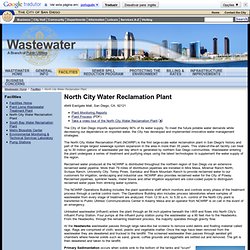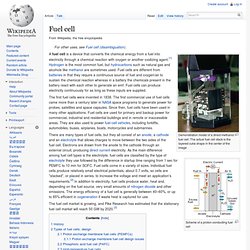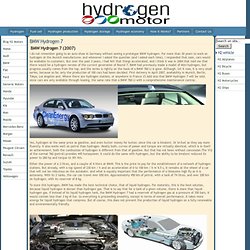

GC Portal. North City Water Reclamation Plant. North City Water Reclamation Plant 4949 Eastgate Mall, San Diego, CA. 92121 The City of San Diego imports approximately 90% of its water supply.

To meet the future potable water demands while decreasing our dependence on imported water, the City has developed and implemented innovative water management strategies. The North City Water Reclamation Plant (NCWRP) is the first large-scale water reclamation plant in San Diego's history and part of the single largest sewerage system expansion in the area in more than 35 years. This state-of-the-art facility can treat up to 30 million gallons of wastewater per day which is generated by northern San Diego communities. ISS ECLSS. The interactions between the components of the ISS Environmental Control and Life Support System (ECLSS) The International Space Station Environmental Control and Life Support System (ECLSS) is a life support system that provides or controls atmospheric pressure, fire detection and suppression, oxygen levels, waste management and water supply.

Cellulosic ethanol. Cellulosic ethanol is a biofuel produced from wood, grasses, or the inedible parts of plants.

It is a type of biofuel produced from lignocellulose, a structural material that comprises much of the mass of plants. Lignocellulose is composed mainly of cellulose, hemicellulose and lignin. Corn stover, Panicum virgatum (switchgrass), Miscanthus grass species, wood chips and the byproducts of lawn and tree maintenance are some of the more popular cellulosic materials for ethanol production. Production of ethanol from lignocellulose has the advantage of abundant and diverse raw material compared to sources such as corn and cane sugars, but requires a greater amount of processing to make the sugar monomers available to the microorganisms typically used to produce ethanol by fermentation. Switchgrass and Miscanthus are the major biomass materials being studied today, due to their high productivity per acre.
History[edit] US President George W. Production methods[edit]
Microbial fuel cell. A microbial fuel cell (MFC) or biological fuel cell is a bio-electrochemical system that drives a current by using bacteria and mimicking bacterial interactions found in nature.

MFCs can be grouped into two general categories, those that use a mediator and those that are mediator-less. The first MFCs, demonstrated in the early 20th century, used a mediator: a chemical that transfers electrons from the bacteria in the cell to the anode. Mediator-less MFCs are a more recent development dating to the 1970s; in this type of MFC the bacteria typically have electrochemically active redox proteins such as cytochromes on their outer membrane that can transfer electrons directly to the anode.[1] Since the turn of the 21st century MFCs have started to find a commercial use in the treatment of wastewater.[2] History[edit] The idea of using microbial cells in an attempt to produce electricity was first conceived in the early twentieth century.
Types[edit] 3D animation of a fuel injected V8. BMW Hydrogen 7 3D Animation. Fuel cell. Demonstration model of a direct-methanol fuel cell.

The actual fuel cell stack is the layered cube shape in the center of the image Scheme of a proton-conducting fuel cell The first fuel cells were invented in 1838. The first commercial use of fuel cells came more than a century later in NASA space programs to generate power for probes, satellites and space capsules. Since then, fuel cells have been used in many other applications. Glowing Jellyfish. India looks to alternative energy. Energy from Thorium.
Renewable energy. Renewable energy is generally defined as energy that comes from resources which are naturally replenished on a human timescale such as sunlight, wind, rain, tides, waves and geothermal heat.[2] Renewable energy replaces conventional fuels in four distinct areas: electricity generation, hot water/space heating, motor fuels, and rural (off-grid) energy services.[3] About 16% of global final energy consumption presently comes from renewable resources, with 10% [4] of all energy from traditional biomass, mainly used for heating, and 3.4% from hydroelectricity.

Donald Sadoway: Liquid Battery. MIT : Grass Solar Power. A researcher at MIT, Andreas Mershin, has created solar panels from agricultural waste such as cut grass and dead leaves.

In a few years, Mershin says it’ll be possible to stir some grass clippings into a bag of cheap chemicals, paint the mixture on your roof, and immediately start producing electricity. If you remember high school biology classes, you will hopefully remember a process called photosynthesis, whereby plants turn sunlight into energy. Mershin has found a process which extracts the photosynthesizing molecules, called photosystem I, from plant matter. Photosystem I contains chlorophyll, the protein that actually converts photons into a flow of electrons. These molecules are then stabilized and spread on a glass substrate that’s covered in a forest of zinc oxide nanowires and titanium dioxide “sponges.” So far so good — now time for the reality check. Read more at MIT. BMW Hydrogen 7 - Hydrogen Motors. I do not remember going to an auto show in Germany without seeing a prototype BMW hydrogen.

For more than 30 years to work on hydrogen at the Munich manufacturer, and whenever I asked the question (and I asked each time), I responded that soon, cars would be available to customers. Hydrogen 7.